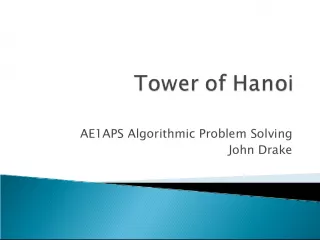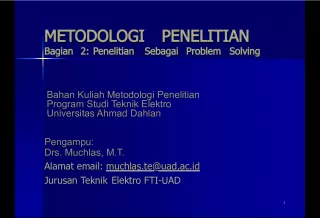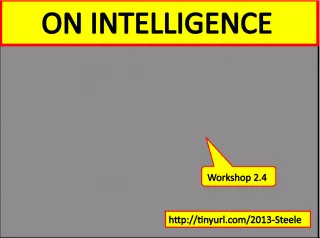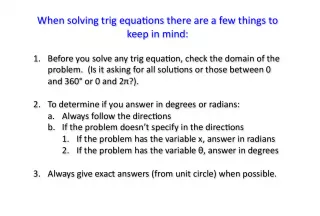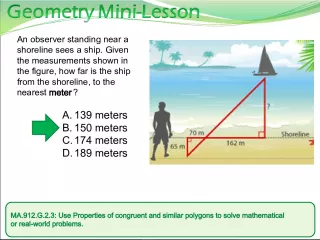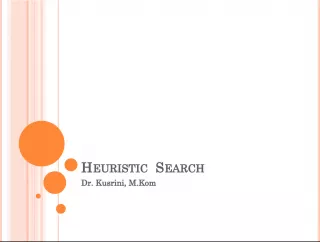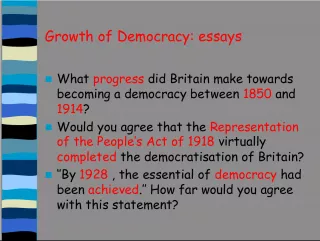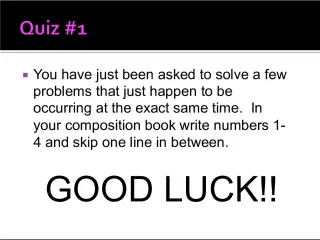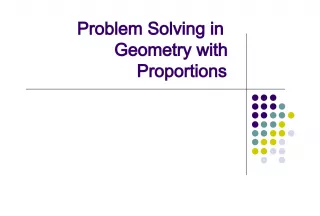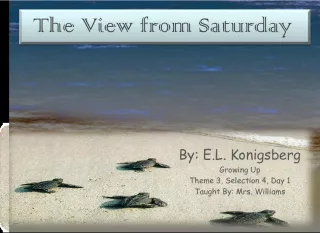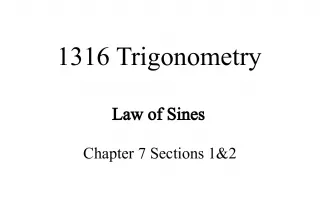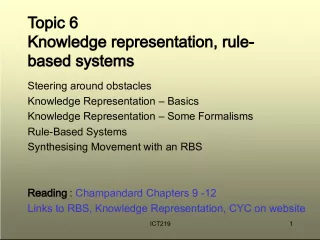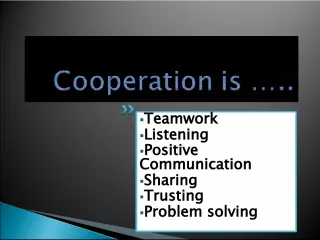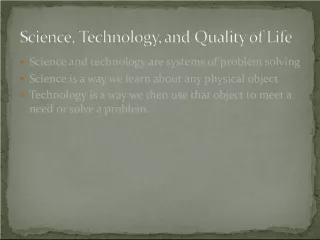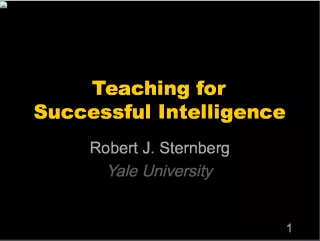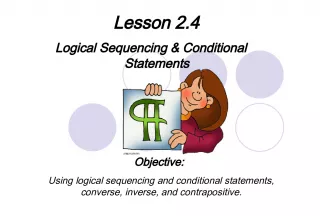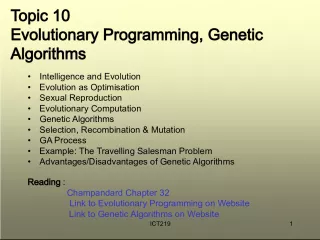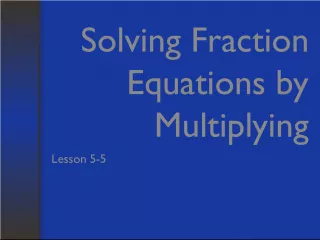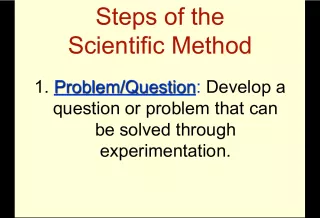Problem Solving and Representation in Artificial Intelligence
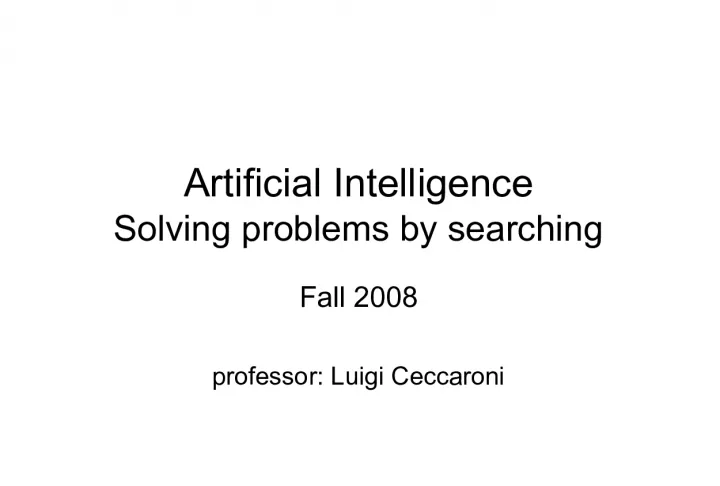

This article discusses the fundamentals of problem solving and representation in AI, including state space, reduction to sub problems, and constraint satisfaction. The Fall 2008 course taught by professor Luigi Ceccaroni is also mentioned.
- Uploaded on | 2 Views
-
 tracewisoky
tracewisoky
About Problem Solving and Representation in Artificial Intelligence
PowerPoint presentation about 'Problem Solving and Representation in Artificial Intelligence'. This presentation describes the topic on This article discusses the fundamentals of problem solving and representation in AI, including state space, reduction to sub problems, and constraint satisfaction. The Fall 2008 course taught by professor Luigi Ceccaroni is also mentioned.. The key topics included in this slideshow are Artificial intelligence, problem solving, problem representation, state space, constraint satisfaction,. Download this presentation absolutely free.
Presentation Transcript
1. Artificial Intelligence Solving problems by searching Fall 2008 professor: Luigi Ceccaroni
2. Problem solving We want: To automatically solve a problem We need: A representation of the problem Algorithms that use some strategy to solve the problem defined in that representation
3. Problem representation General: State space : a problem is divided into a set of resolution steps from the initial state to the goal state Reduction to sub-problems : a problem is arranged into a hierarchy of sub-problems Specific: Game resolution Constraints satisfaction
4. States A problem is defined by its elements and their relations. In each instant of the resolution of a problem, those elements have specific descriptors (How to select them?) and relations. A state is a representation of those elements in a given moment. Two special states are defined: Initial state (starting point) Final state (goal state)
5. State modification: successor function A successor function is needed to move between different states. A successor function is a description of possible actions, a set of operators. It is a transformation function on a state representation, which convert it into another state. The successor function defines a relation of accessibility among states. Representation of the successor function: Conditions of applicability Transformation function
6. State space The state space is the set of all states reachable from the initial state. It forms a graph (or map) in which the nodes are states and the arcs between nodes are actions. A path in the state space is a sequence of states connected by a sequence of actions. The solution of the problem is part of the map formed by the state space.
7. Problem solution A solution in the state space is a path from the initial state to a goal state or, sometimes, just a goal state. Path/solution cost : function that assigns a numeric cost to each path, the cost of applying the operators to the states Solution quality is measured by the path cost function, and an optimal solution has the lowest path cost among all solutions. Solutions: any, an optimal one, all. Cost is important depending on the problem and the type of solution sought.
8. Problem description Components: State space (explicitly or implicitly defined) Initial state Goal state (or the conditions it has to fulfill) Available actions (operators to change state) Restrictions (e.g., cost) Elements of the domain which are relevant to the problem (e.g., incomplete knowledge of the starting point) Type of solution: Sequence of operators or goal state Any, an optimal one (cost definition needed), all
9. Example: 8-puzzle 8 2 3 4 1 6 7 5
10. Example: 8-puzzle State space : configuration of the eight tiles on the board Initial state : any configuration Goal state : tiles in a specific order Operators or actions : blank moves Condition: the move is within the board Transformation: blank moves Left , Right , Up , or Down Solution : optimal sequence of operators
11. Example: n queens (n = 4, n = 8)
12. Example: n queens (n = 4, n = 8) State space : configurations from 0 to n queens on the board with only one queen per row and column Initial state : configuration without queens on the board Goal state : configuration with n queens such that no queen attacks any other Operators or actions : place a queen on the board Condition: the new queen is not attacked by any other already placed Transformation: place a new queen in a particular square of the board Solution : one solution (cost is not considered)
13. Structure of the state space Data structures: Trees: only one path to a given node Graphs: several paths to a given node Operators: directed arcs between nodes The search process explores the state space. In the worst case all possible paths between the initial state and the goal state are explored.
14. Search as goal satisfaction Satisfying a goal Agent knows what the goal is Agent cannot evaluate intermediate solutions (uninformed) The environment is: Static Observable Deterministic
15. Example: holiday in Romania On holiday in Romania; currently in Arad Flight leaves tomorrow from Bucharest at 13:00 Lets configure this to be an AI problem
16. Romania Whats the problem? Accomplish a goal Reach Bucharest by 13:00 So this is a goal-based problem
17. Romania Whats an example of a non-goal-based problem? Live long and prosper Maximize the happiness of your trip to Romania Dont get hurt too much
18. Romania What qualifies as a solution? You can/cannot reach Bucharest by 13:00 The actions one takes to travel from Arad to Bucharest along the shortest (in time) path
19. Romania What additional information does one need? A map
20. A state space Which cities could you be in? An initial state Which city do you start from? A goal state Which city do you aim to reach? A function defining state transitions When in city foo, the following cities can be reached A function defining the cost of a state sequence How long does it take to travel through a city sequence? More concrete problem definition
21. More concrete problem definition A state space Choose a representation An initial state Choose an element from the representation A goal state Create goal_function(state) such that TRUE is returned upon reaching goal A function defining state transitions successor_function(state i ) = {
22. Important notes about this example Static environment (available states, successor function, and cost functions dont change) Observable (the agent knows where it is) Discrete (the actions are discrete) Deterministic (successor function is always the same)
23. Tree search algorithms Basic idea: Simulated exploration of state space by generating successors of already explored states (AKA expanding states) Sweep out from start (breadth)
24. Tree search algorithms Basic idea: Simulated exploration of state space by generating successors of already explored states (AKA expanding states) Go East, young man! (depth)
25. Implementation: general search algorithm Algorithm General Search Open_states.insert (Initial_state) Current= Open_states.first() while not is_final?(Current) and not Open_states.empty?() do Open_states.delete_first() Closed_states.insert(Current) Successors= generate_successors(Current) Successors= process_repeated(Successors, Closed_states, Open_states) Open_states.insert(Successors) Current= Open_states.first() eWhile eAlgorithm
26. Example: Arad Bucharest Algorithm General Search Open_states.insert (Initial_state) Arad
27. Arad Example: Arad Bucharest Current= Open_states.first()
28. Arad Zerind (75) Timisoara (118) Sibiu (140) Example: Arad Bucharest while not is_final?(Current) and not Open_states.empty?() do Open_states.delete_first() Closed_states.insert(Current) Successors= generate_successors(Current) Successors= process_repeated(Successors, Closed_states, Open_states) Open_states.insert(Successors)
29. Arad Zerind (75) Timisoara (118) Sibiu (140) Example: Arad Bucharest Current= Open_states.first()
30. Arad Zerind (75) Timisoara (118) Sibiu (140) Dradea (151) Faragas (99) Rimnicu Vilcea (80) Example: Arad Bucharest while not is_final?(Current) and not Open_states.empty?() do Open_states.delete_first() Closed_states.insert(Current) Successors= generate_successors(Current) Successors= process_repeated(Successors, Closed_states, Open_states) Open_states.insert(Successors)
31. Implementation: states vs. nodes State (Representation of) a physical configuration Node Data structure constituting part of a search tree Includes parent, children, depth, path cost g(x) States do not have parents, children, depth, or path cost!
32. Search strategies A strategy is defined by picking the order of node expansion Strategies are evaluated along the following dimensions: Completeness does it always find a solution if one exists? Time complexity number of nodes generated/expanded Space complexity maximum nodes in memory Optimality does it always find a least-cost solution?
33. Search strategies Time and space complexity are measured in terms of: b maximum branching factor of the search tree (may be infinite) d depth of the least-cost solution m maximum depth of the state space (may be infinite)
34. Uninformed Search Strategies Uninformed strategies use only the information available in the problem definition Breadth-first search Uniform-cost search Depth-first search Depth-limited search Iterative deepening search
35. 35 Nodes Open nodes: Generated, but not yet explored Explored, but not yet expanded Closed nodes: Explored and expanded 35
36. Breadth-first search Expand shallowest unexpanded node Implementation: A FIFO queue, i.e., new successors go at end
37. Space cost of BFS Because you must be able to generate the path upon finding the goal state, all visited nodes must be stored O (b d+1 )
38. Properties of breadth-first search Complete ? Yes (if b (max branch factor) is finite) Time? 1 + b + b 2 + + b d + b(b d -1) = O(b d+1 ), i.e., exponential in d Space? O(b d+1 ) (keeps every node in memory) Optimal? Only if cost = 1 per step, otherwise not optimal in general Space is the big problem; it can easily generate nodes at 10 MB/s, so 24 hrs = 860GB!
39. Depth-first search Expand deepest unexpanded node Implementation: A LIFO queue, i.e., a stack
40. Depth-first search Complete? No: fails in infinite-depth spaces, spaces with loops. Can be modified to avoid repeated states along path complete in finite spaces Time? O(b m ) : terrible if m is much larger than d , but if solutions are dense, may be much faster than breadth-first Space? O(bm), i.e., linear space! Optimal? No
41. 41 Depth-limited search It is depth-first search with an imposed limit on the depth of exploration, to guarantee that the algorithm ends. 41
42. 42 Treatment of repeated states Breadth-first: If the repeated state is in the structure of closed or open nodes, the actual path has equal or greater depth than the repeated state and can be forgotten. 42
43. 43 Treatment of repeated states Depth-first: If the repeated state is in the structure of closed nodes, the actual path is kept if its depth is less than the repeated state. If the repeated state is in the structure of open nodes, the actual path has always greater depth than the repeated state and can be forgotten. 43
44. Iterative deepening search
45. 45 Iterative deepening search The algorithm consists of iterative, depth-first searches, with a maximum depth that increases at each iteration. Maximum depth at the beginning is 1. Behavior similar to BFS, but without the spatial complexity. Only the actual path is kept in memory; nodes are regenerated at each iteration. DFS problems related to infinite branches are avoided. To guarantee that the algorithm ends if there is no solution, a general maximum depth of exploration can be defined. 45
46. Iterative deepening search
47. Summary All uninformed searching techniques are more alike than different. Breadth-first has space issues, and possibly optimality issues. Depth-first has time and optimality issues, and possibly completeness issues. Depth-limited search has optimality and completeness issues. Iterative deepening is the best uninformed search we have explored.
48. 48 Uninformed vs. informed Blind (or uninformed) search algorithms: Solution cost is not taken into account. Heuristic (or informed) search algorithms: A solution cost estimation is used to guide the search. The optimal solution, or even a solution, are not guaranteed. 48
